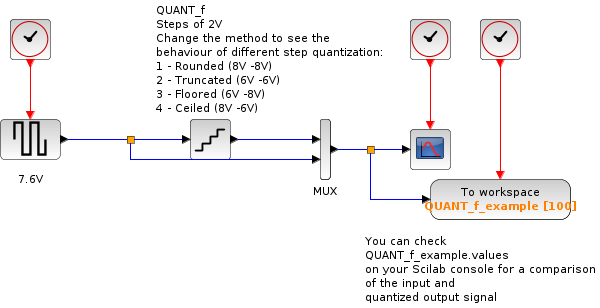QUANT_f
Quantization
Block Screenshot

Contents
Description
This block outputs the quantization of the input according to a choice of methods (quantization types):
1: Round
Rounding the number of quantization steps (output signal is the nearest step)
2: Truncation
Truncating the number of quantization steps (output signal is the nearest step towards 0)
3: Floor
Rounding down the number of quantization steps (output signal is the nearest step towards -∞)
4: Ceil
Rounding up the number of quantization steps (output signal is the nearest step towards +∞)
Parameters

Step
scalar, Quantization step
Properties : Type 'vec' of size 1.
Quantization Type
scalar with possible values 1,2,3 or 4: the method of quantization used (respectively Truncation, Floor or Ceil)
Properties : Type 'vec' of size 1.
Default properties
always active: no
direct-feedthrough: yes
zero-crossing: no
mode: no
regular inputs:
- port 1 : size [-1,1] / type 1
regular outputs:
- port 1 : size [-1,1] / type 1
number/sizes of activation inputs: 0
number/sizes of activation outputs: 0
continuous-time state: no
discrete-time state: no
object discrete-time state: no
name of computational function: qzrnd
Examples
Example of a sine quantized every 0.2 step with the Ceil method (using the ceil value between two steps):


Comparison of the different quantization modes:


Interfacing function
SCI/modules/scicos_blocks/macros/NonLinear/QUANT_f.sci
Computational function
- SCI/modules/scicos_blocks/src/fortran/qzrnd.f
- SCI/modules/scicos_blocks/src/fortran/qztrn.f
- SCI/modules/scicos_blocks/src/fortran/qzflr.f
- SCI/modules/scicos_blocks/src/fortran/qzcel.f
| Report an issue | ||
| << Signalprocessing_pal | Signal processing palette | SAMPHOLD_m >> |